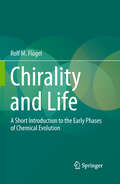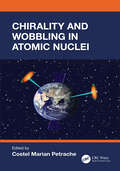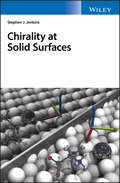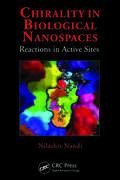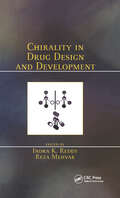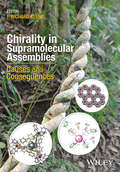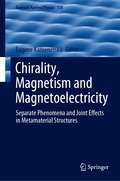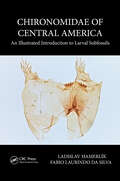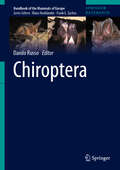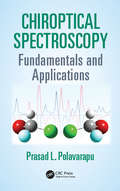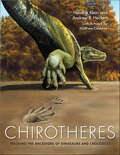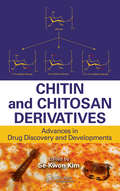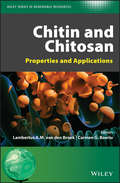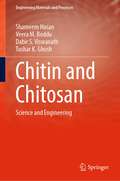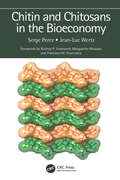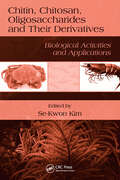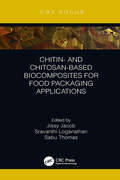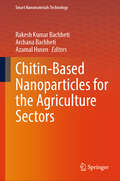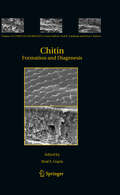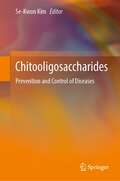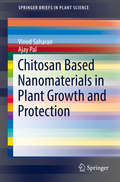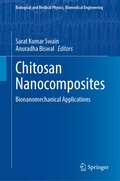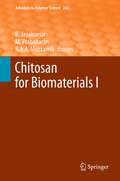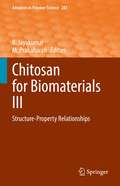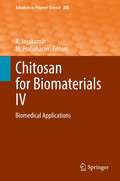- Table View
- List View
Chirality and Life: A Short Introduction to the Early Phases of Chemical Evolution
by Rolf M. FlügelThis book presents the fascinating formation of the first simple bioorganic molecules and describes the hidden aspects of chiral compounds, which raise questions on the molecular beginnings of life. The occurrences of extraterrestrial, non-standard amino acids in meteorites are dealt with in detail, as well as their subsequent transfer to proteinogenic amino acids. The concept of asymmetric organo-catalysis for the synthesis of carbohydrates and ribonucleosides are considered. The notion of a single amino acid that functions as an enzyme is developed. Attempts to simulate ancient world scenarios are critically reviewed. There is a special focus on ribozymes and the resulting RNA world. Combinations of different world scenarios are discussed in view of an on-going evolution. The currently most plausible hypotheses and visions of ancient world scenarios that led to today's DNA world are also provided. Included is a pre-cellular world of viruses that is presented for the first time.
Chirality and Wobbling in Atomic Nuclei
by Costel Marian PetracheThe book provides an introduction to both theoretical and experimental results on chirality and wobbling in atomic nuclei.It details the achievements in the study of chirality over the past 25 years since the first prediction of this mode of collective motion in nuclei, as well as those on the wobbling motion. It offers a detailed review of the most relevant theoretical developments on both types of collective motion and the experimental results supporting or not the theoretical predictions.Different views on wobbling are included and confronted with the contradicting experimental results on low-spin wobbling. It is intended to foster further the research on these types of exotic collective motion in nuclei. Which and how these exotic collective motions occur in nuclei, which are their predicted fingerprints and how they are supported by the experimental facts will be presented. Polemics, debates, and ambiguities of the interpretation of the experimental results will be exposed.The reader will have the opportunity to have together different views on the two phenomena which animated the scientific activity in low-energy nuclear physics in many laboratories around the world. The book will be a valuable reference for PhD students, post-docs and researchers in addition to universities and research institutions.Key Features: The first book on chirality and wobbling in nuclei Contains a comprehensive review of topics related to chirality and wobbling, including both theoretical and experimental aspects Contains chapters from leading researchers in the field.
Chirality at Solid Surfaces
by Stephen J. JenkinsA comprehensive introduction to the fundamental aspects of surface chirality, covering both chemical and physical consequences Written by a leading expert in the field, Chirality at Solid Surfaces offers an introduction to the concept of chirality at surfaces, starting from the foundation of chirality in isolated molecules and bulk systems. Fundamental properties such as surface energy and surface stress are then linked to a universal systematization of surface structure and symmetry. The author includes key examples of surface chemistry and physics, such as the interplay between adsorbate and substrate chirality, amplification of chirality, chiral catalysis, and the influence of surface chirality upon optical and magnetic phenomena. The book also explores the chirality apparent in the electronic structure of graphene, topological insulators and half-metallic materials. This important reference: Provides an introduction to the fundamental concept of chirality Contains discussions of the chemical and physical consequences of surface chirality, including magnetic, electronic and optical properties in addition to molecular properties Offers an account of the most current research needed to support growth in the field Written for surface scientists, professionals in the field, academics, and students, Chirality at Solid Surfaces is an essential resource that contains an overview of the fundamentals of surface chirality and reviews both the chemical and physical consequences.
Chirality in Biological Nanospaces: Reactions in Active Sites
by Nilashis NandiChirality is widely studied and omnipresent in biological molecules. However, how the retention of enantiomeric forms persists in many life processes without racemization is still unclear, and the molecular understanding of the stringent chiral specificity in enzymatic reactions is sparse. Vital life processes occur within the active sites of large biological macromolecules such as proteins, nucleic acids, and lipids. These nanodimensional structures greatly accelerate biological reactions. The chirality of the reactants also has a strong influence on the process, but its importance in such biological reactions has only recently begun to be understood. This book explores the influence of chirality on reaction mechanisms in such biological nanospaces. The text addresses the influence of the chirality of amino acid and sugar in the active sites of transferase, oxidoreductases, hydrolases, lysases, isomerase, ligases, and other systems. It also covers ribosomal architecture.
Chirality in Drug Design and Development
by Indra K. Reddy Reza MehvarCovering every essential element in the development of chiral products, this reference provides a solid overview of the formulation, biopharmaceutical characteristics, and regulatory issues impacting the production of these pharmaceuticals. It supports researchers as they evaluate the pharmacodynamic, pharmacokinetic, and toxicological characterist
Chirality in Supramolecular Assemblies: Causes and Consequences
by F. Richard KeeneSupramolecular chemistry deals with the organisation of molecules into defined assemblies using non-covalent interactions, including weaker and reversible interactions such as hydrogen bonds, and metal-ligand interactions. The aspect of stereochemistry within such chemical architectures, and in particular chirality, is of special interest as it impacts on considerations of molecular recognition, the development of functional materials, the vexed question of homochirality, nanoscale effects of interactions at interfaces, biocatalysis and enzymatic catalysis, and applications in organic synthesis. Chirality in Supramolecular Assemblies addresses many of these aspects, presenting a broad overview of this important and rapidly developing interdisciplinary field. Topics covered include: * Origins of molecular and topological chirality * Homochirogenesis * Chirality in crystallinity * Host-guest behavior * Chiral influences in functional materials * Chirality in network solids and coordination solids * Aspects of chirality at interfaces * Chirality in organic assemblies * Chirality related to biocatalysis and enzymes in organic synthesis. This book is a valuable reference for researchers in the molecular sciences, materials science and biological science working with chiral supramolecular systems. It provides summaries and special insights by acknowledged international experts in the various fields.
Chirality, Magnetism and Magnetoelectricity: Separate Phenomena and Joint Effects in Metamaterial Structures (Topics in Applied Physics #138)
by Eugene KamenetskiiThis book discusses theoretical and experimental advances in metamaterial structures, which are of fundamental importance to many applications in microwave and optical-wave physics and materials science. Metamaterial structures exhibit time-reversal and space-inversion symmetry breaking due to the effects of magnetism and chirality. The book addresses the characteristic properties of various symmetry breaking processes by studying field-matter interaction with use of conventional electromagnetic waves and novel types of engineered fields: twisted-photon fields, toroidal fields, and magnetoelectric fields. In a system with a combined effect of simultaneous breaking of space and time inversion symmetries, one observes the magnetochiral effect. Another similar phenomenon featuring space-time inversion symmetries is related to use of magnetoelectric materials. Cross-coupling of the electric and magnetic components in these material structures, leading to the appearance of new magnetic modes with an electric excitation channel – electromagnons and skyrmions – has resulted in a wealth of strong optical effects such as directional dichroism, magnetochiral dichroism, and rotatory power of the fields. This book contains multifaceted contributions from international leading experts and covers the essential aspects of symmetry-breaking effects, including theory, modeling and design, proven and potential applications in practical devices, fabrication, characterization and measurement. It is ideally suited as an introduction and basic reference work for researchers and graduate students entering this field.
Chironomidae of Central America: An Illustrated Introduction To Larval Subfossils
by Ladislav Hamerlik Fabio Laurindo da SilvaThis illustrated introduction to Central American Chironomidae offers extensive photographic material, as well as detailed morphological and ecological descriptions of chironomid subfossils found in Central American lake sediments. The book uniquely provides two identification keys: one for living larvae occurring (or potentially being present) in Central America and one for the recorded subfossil remains, using limited morphological characters. Paleolimnological investigations using chironomid remains have undergone a resurgence of interest, and this taxonomic guide will aid the thorough analysis of the diversity and distribution of the taxa encountered to date in Central America. Out of the total 64 described genera, the book brings 20 endemic genera, and more than half of the presented morphotypes are new. Plates are included for each taxon with generic characters and also provide a key to morphotypes, if present, their specific characters, distribution, and ecology. Authored by a (paleo)limnologist and a taxonomist, the guide draws on a thorough taxonomical knowledge of the region’s recent chironomid fauna. It uses a paleolimnological approach to transmit this information to morphotypes that can be linked with ecology and used to reconstruct the past development of nature. The book thus helps paleo-workers and taxonomists to learn more about these fascinating insects and, through them, to discover the world around us. Providing a comprehensive reference for aquatic ecologists, paleolimnologists, students, and researchers, the guide will also be of interest to non-academic professionals working on applied research and biomonitoring of lakes. It will be useful for people studying both recent and subfossil material, not only in Central America, but in the whole Neotropical region.
Chiroptera (Handbook of the Mammals of Europe)
by Danilo RussoPreliminaryThis volume provides comprehensive overviews of each European bat species’ biology including palaeontology, physiology, genetics, reproduction and development, ecology, habitat, diet, mortality and age determination. Their economic significance and management, as well as future challenges for research and conservation are also addressed. Each chapter includes a distribution map, a photograph of the animal and key literature. This authoritative volume of the Handbook of the Mammals of Europe is a timely and detailed compilation of all European bats and will appeal to academics, students and professionals in mammal research.
Chiroptical Spectroscopy: Fundamentals and Applications
by Prasad L. PolavarapuThis book details chiroptical spectroscopic methods: electronic circular dichroism (ECD), optical rotatory dispersion (ORD), vibrational circular dichroism (VCD), and vibrational Raman optical activity (VROA). For each technique, the text presents experimental methods for measurements and theoretical methods for analyzing the experimental data. It also includes a set of experiments that can be adopted for undergraduate teaching laboratories. Each chapter is written in an easy-to-follow format for novice readers, with necessary theoretical formalism in appendices for advanced readers.
Chirotheres: Tracking the Ancestors of Dinosaurs and Crocodiles (Life of the Past)
by Hendrik Klein Andrew B. HeckertComprehensive in detail and worldwide in scope, Chirotheres is the definitive compendium of what is known about the five-toed footprints of Triassic archosaurs, ancestors of the crocodiles. Sandstone slabs with extensive trackways have been known for almost two centuries and are highlights in museum exhibits around the globe. These trackways provide direct insight into the locomotion and behavior of the fascinating reptiles that made these tracks, and, together with known skeletons, they allow a richer reconstruction of chirothere lifestyle than is possible from bones alone.Written by expert researchers in the fields of vertebrate ichnology, vertebrate paleontology, and scientific illustration, Chirotheres explores the various facets ofchirothere research including the history of their study, footprint formation and preservation, the bone record, the environment and lifestyle of chirotheres, and finally, their disappearance at the end of the Triassic.Chirotheres also featuresa global compendium of track collections with chirothere material, including specimen numbers, detailed phylogenetic definitions of track makers, and extensive measurements from key chirothere tracks and trackways. It represents an invaluable resource of anyone interested in these ancient animals.
Chitin and Chitosan Derivatives: Advances in Drug Discovery and Developments
by Jie ZhangA natural long-chain polymer, chitin is the main component of the cell walls of fungi, the exoskeletons of arthropods (including crustaceans and insects), the radulas of mollusks, and the beaks and internal shells of cephalopods. However, marine crustacean shells are the primary sources of the chitin derivative chitosan. Chitin and chitosan are use
Chitin and Chitosan: Properties and Applications (Wiley Series in Renewable Resource)
by Christian V. StevensOffers a comprehensive guide to the isolation, properties and applications of chitin and chitosan Chitin and Chitosan: Properties and Applications presents a comprehensive review of the isolation, properties and applications of chitin and chitosan. These promising biomaterials have the potential to be broadly applied and there is a growing market for these biopolymers in areas such as medical and pharmaceutical, packaging, agricultural, textile, cosmetics, nanoparticles and more. The authors – noted experts in the field – explore the isolation, characterization and the physical and chemical properties of chitin and chitosan. They also examine their properties such as hydrogels, immunomodulation and biotechnology, antimicrobial activity and chemical enzymatic modifications. The book offers an analysis of the myriad medical and pharmaceutical applications as well as a review of applications in other areas. In addition, the authors discuss regulations, markets and perspectives for the use of chitin and chitosan. This important book: Offers a thorough review of the isolation, properties and applications of chitin and chitosan. Contains information on the wide-ranging applications and growing market demand for chitin and chitosan Includes a discussion of current regulations and the outlook for the future Written for Researchers in academia and industry who are working in the fields of chitin and chitosan, Chitin and Chitosan: Properties and Applications offers a review of these promising biomaterials that have great potential due to their material properties and biological functionalities.
Chitin and Chitosan: Science and Engineering (Engineering Materials and Processes)
by Tushar K. Ghosh Veera M. Boddu Dabir S. Viswanath Shameem HasanThis book reviews work that covers everything from basic chemistry to advanced applications. Chitin and chitosan are used in a plethora of applications from wastewater treatment to prosthetics. After introducing the subject of polysaccharides as a whole, the authors turn to the preparation of chitin and chitosan and the characterization of the latter. The book provides information on chitin chemistry, extraction of chitin, chitosan preparation processes, and the applications of their derivatives in various fields. Among the applications that are included in detail are the adsorption of heavy metals for pollution prevention and clean-up, biosensors, cosmetics, various medical applications from anti-tumor activity to bone tissue engineering, agriculture and food production, and proton exchange membranes for fuel cells.Chitin and Chitosan features:• information on molecular structure, synthesis, properties, and latest research related to chitin and chitosan;• coverage of a wide range of topics from the properties of chitosan to its derivatives and applications;• in-depth information on biomedical applications of chitin and chitosan; and• information that can be applied to other biopolymer processing engineering areas.This book will be of interest to practitioners working in a wide variety of industries for which chitin and chitosan are useful materials, researchers in biosensors and heavy-metal adsorption, and to academic researchers investigating the properties, preparation, and uses of these materials.
Chitin and Chitosans in the Bioeconomy
by Jean-Luc Wertz Serge PerezChitin is the second most abundant natural polymer in the world after cellulose, mainly derived from the food waste of shrimp and crabs. Chitosan is the most important derivative of chitin. Thanks to their biodegradability, non-toxicity, biocompatibility, bioactivity, and versatile chemical and physical properties, chitin and chitosan derivatives are used in a wide variety of applications, including water treatment, cosmetics and toiletries, food and beverages, healthcare/medical, and agrochemicals. Chitin and Chitosans in the Bioeconomy covers all major aspects of chitin and chitosan, including structure, biosynthesis, biodegradation, properties of chitin and derivatives, applications, and market. It offers a special focus on the bioeconomy, which is the renewable segment of the circular economy. Describes the structure, biosynthesis, and biodegradation of chitin and chitosan Covers chitin- and chitosan-based products Details valorization of these materials Presents information on shell biorefineries Chitin and Chitosans in the Bioeconomy serves as a reference for polymer scientists and engineers and is also accessible to economists and advanced students.
Chitin, Chitosan, Oligosaccharides and Their Derivatives: Biological Activities and Applications
by Se-Kwon KimBiopolymers found in marine animals and plants offer tremendous, largely untapped pharmaceutical potential. Research shows that these biopolymers can be used to combat various infectious as well as inflammatory, oxidative, and carcinogenic factors. Chitin, Chitosan, Oligosaccharides and Their Derivatives: Biological Activities and Applications cove
Chitin- and Chitosan-Based Biocomposites for Food Packaging Applications
by Sabu Thomas Jissy Jacob Sravanthi LoganathanChitin is one of the most important biopolymers, synthesized by an enormous number of living organisms and is a promising bioactive polymer for food packaging applications due to its functional properties. This book focuses on composition, properties, characterization, and theoretical approach of chitin and chitosan bio-composites. It describes the most recent studies concerning chitin and chitosan-based films and gives an overview about future trends regarding the industrial applications of chitin and chitosan for food packaging purposes. This book is especially useful for researchers in the fields of bionanocomposites, especially those with an interest in packaging applications.
Chitin-Based Nanoparticles for the Agriculture Sectors (Smart Nanomaterials Technology)
by Azamal Husen Rakesh Kumar Bachheti Archana BachhetiThis book provides an overview of chitin-based nanoparticles, including their properties, synthesis methods, and characterization techniques. It will also discuss the potential uses of chitin-based nanoparticles in agriculture, such as in crop protection, nutrient delivery, and soil improvement as well as potential areas for future research and development. Overall, the book would present a comprehensive and accessible resource for researchers, agricultural workers, policymakers, and other stakeholders who are interested in learning about the potential applications and benefits of chitin-based nanoparticles in agriculture.
Chitin: Formation and Diagenesis (Topics in Geobiology #34)
by Neal S. GuptaThere are several books on properties of chitin and associated biomolecules and their biochemical significance. However, the present volume deals with a wide variety of biogeochemical and organic geochemical aspects of this vital macromolecule written by leading authors and experts in the field. Each chapter is carefully peer reviewed and is an updated account of recent research in isotopic, nanostructural, biochemical, microstructural, geochemical, paleontological and experimental aspects of chitin formation, distribution and preservation in the environment and earth history.
Chitooligosaccharides: Prevention and Control of Diseases
by Se-Kwon KimThis book outlines the production of chitooligossacharides and their derivatives and discusses their main biological activities, biomedical applications and their role in disease prevention. Chitooligosaccharides are products of chitosan or chitin degradation, prepared by enzymatic or chemical hydrolysis of chitosan, and they consist mainly of N-acetyl glucosamine and glucosamine bonded with a glycosidic bond. Compared to chitin and chitosan, chitooligossacharides offer advantages for large-scale and commercial applications due to their solubility in water and lower molecular weight.Written by leading experts, this book is divided into four parts. The first part provides a general introduction to chitooligossacharides. The second part focuses on the bioproduction of chitooligossacharides through enzymatic synthesis and also covers physical and chemical methods of synthesis. The third part explores the major biological activities of chitooligosaccharides, including antioxidant, antimicrobial, anti-allergic, anti-inflammatory, anti-cancer and neuroprotective activities, and discusses the disease preventing mechanisms of chitooligosaccharides. In this section, readers will also find about the latest in vivo studies which support the use of chitooligosaccharides in the prevention and control of disease. The final part highlights important biomedical applications of chitooligosaccharides, including in tissue engineering, drug delivery and wound healing applications. It also includes the volume editor’s perspective on the health and safety risks of chitooligosaccharides.Given its scope, this book is useful not only for researches in the field but also for students interested in biomaterials, pharmaceuticals, marine biotechnology, nutraceuticals and food science.
Chitosan Based Nanomaterials in Plant Growth and Protection (SpringerBriefs in Plant Science)
by Vinod Saharan Ajay PalThis brief describes various methods of chitosan nano-materials synthesis, with detailed discussion of various factors effecting its synthesis process, stability and physicochemical properties. Chitosan is naturally occurring biopolymer derived from chitin. Due to the unique biological properties of chitosan nano-materials such as antimicrobial, plant growth inducer, plant defense modulator, chitosan has gained attention in fields of plant sciences. Book further extended the details of different types of chitosan nano-materials specially for plant applications along with its future prospects in plant protection and growth. Bioactivities of chitosan nano-materials and its mechanism have also been covered. This book aims to widening the understanding of the synthesis, characterization and use of chitosan based nano-materials in plant system.
Chitosan Nanocomposites: Bionanomechanical Applications (Biological and Medical Physics, Biomedical Engineering)
by Sarat Kumar Swain Anuradha BiswalThe book presents chitosan and chitosan-based nanocomposites and their extensive applications in medical science. Utilization of chitosan nanostructured composites in different biomedical applications is highlighted. The book is suitable to be used as reference/textbook for studying the biological aspects of chitosan hybrid materials and their efficacy in different therapeutic applications. The important features of the book are summarized as follows:Chitosan as an overviewKey biological aspects of chitosan-based nanocompositesSynthetic techniques for fabrication of chitosan nanocomposites for biomedical applicationsDesigning of chitosan-based smart materials for release of therapeuticsFabrication of nanostructured chitosan-based devices for diagnosis and sensing applicationsChitosan nanocomposites for regenerative applicationsMedicinal and therapeutic efficacy of chitosan-based hybrid materials.
Chitosan for Biomaterials I (Advances in Polymer Science #243)
by Riccardo A. Muzzarelli M. Prabaharan R. JayakumarPolymeric Nanoparticles of Chitosan Derivatives as DNA and siRNA Carriers, by Y. K. Kim, H. L. Jiang, Y. J. Choi, I. K. Park, M. H. Cho and C. S. Cho.- Chitosan and Its Derivatives for Drug Delivery Perspective, by T. A. Sonia and C. P. Sharma.- Chitosan-based Nanoparticles in Cancer Therapy, by V.-K. Lakshmanan, K. S. Snima, J. D. Bumgardner, S. V. Nair, and R. Jayakumar.- Chitosan and Thiolated Chitosan, by F. Sarti and A. Bernkop-Schnürch.- Chitosan-Based Particulate Systems for Non-Invasive Vaccine Delivery, by S. Şenel.- Multifunctional Chitosan Nanoparticles for Tumor Imaging and Therapy, by J. Y. Yhee, Heebeom Koo, Dong Eun Lee, Kuiwon Choi, Ick Chan Kwon and Kwangmeyung Kim.- Chitosan-Coated Iron Oxide Nanoparticles for Molecular Imaging and Drug Delivery, by H. Arami, Z. Stephen, O. Veiseh and M. Zhang.- Chitosan: Its Applications in Drug-Eluting Devices, by Mei -Chin Chen, Fwu -Long Mi, Zi -Xian Liao and Hsing -Wen Sung.-
Chitosan for Biomaterials III: Structure-Property Relationships (Advances in Polymer Science #287)
by M. Prabaharan R. JayakumarThis volume deals with chemical modification, structure-property relationship, biological interaction and biomedical applications of chitosan and its chemically modified derivatives. The chapters of this volume provide an overview of the structural comparison of chitosan with other sugar-based biopolymers, a different type of strategy used in chemical modification of chitosan to interact with metal ions and to enhance antimicrobial activity. The chapters further discuss the development of functionalized chitosan hydrogels, films, scaffolds and composites that have the potential to be used in food packaging, enhancing saltiness, biosensors and wound dressing. In addition the fabrication and biological properties of chitosan and its derivatives-based nanofibers are presented. Another important aspect covered in this volume is that of the interaction of chitosan with blood, platelet-rich plasma and stem cells. Finally, this volume presents the current challenges in the development of biomedical products based on chitosan and its derivatives. The volume will be of interest to chemists, material science, biological science and biomaterial scientists can able to understand structure-property relationship, biological interaction and biomedical applications of chitosan and its derivatives.
Chitosan for Biomaterials IV: Biomedical Applications (Advances in Polymer Science #288)
by M. Prabaharan R. JayakumarThis volume presents the recent developments on the biomedical applications of chitosan and its derivatives. Chitosan exhibits unique properties such as non-toxicity, biodegradability and biocompatibility. Since its chemical structure and properties can be easily modified, it can be an ideal candidate as a biomaterial. Consequently, chitosan and its derivatives are being developed in different forms such as nanoparticles, micelles, nanofibers, hydrogels, films and 3D porous materials for various biomedical applications, ranging from drug and gene delivery to tissue engineering and regenerative medicine. The chapters of this volume focus on the potential use of chitosan and its derivatives as a hemostatic agent, tissue sealants, tissue engineering scaffolds, delivery carriers for bioactive molecules in bone tissue engineering and wound dressings. Some chapter’s deal with recent advancements of chitosan-based biomaterials as a drug, gene and transdermal drug delivery carrier. In addition, the volume focusses on the prospects of chitosan-based systems for the treatment of cancer, eye and other infectious diseases. The volume will be of interest to material scientists, chemists and biotechnologists by providing a better understanding of the physicochemical and biological characteristics of chitosan and its derivatives to develop more appropriate and innovative chitosan-based materials modified for unlimited practical applications in biomedical fields.
